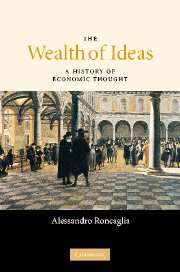Book contents
- Frontmatter
- Contents
- Preface
- 1 The history of economic thought and its role
- 2 The prehistory of political economy
- 3 William Petty and the origins of political economy
- 4 From body politic to economic tables
- 5 Adam Smith
- 6 Economic science at the time of the French Revolution
- 7 David Ricardo
- 8 The ‘Ricardians’ and the decline of Ricardianism
- 9 Karl Marx
- 10 The marginalist revolution: the subjective theory of value
- 11 The Austrian school and its neighbourhood
- 12 General economic equilibrium
- 13 Alfred Marshall
- 14 John Maynard Keynes
- 15 Joseph Schumpeter
- 16 Piero Sraffa
- 17 The age of fragmentation
- 18 Where are we going? Some (very tentative) considerations
- References
- Index of names
- Subject index
12 - General economic equilibrium
Published online by Cambridge University Press: 22 September 2009
- Frontmatter
- Contents
- Preface
- 1 The history of economic thought and its role
- 2 The prehistory of political economy
- 3 William Petty and the origins of political economy
- 4 From body politic to economic tables
- 5 Adam Smith
- 6 Economic science at the time of the French Revolution
- 7 David Ricardo
- 8 The ‘Ricardians’ and the decline of Ricardianism
- 9 Karl Marx
- 10 The marginalist revolution: the subjective theory of value
- 11 The Austrian school and its neighbourhood
- 12 General economic equilibrium
- 13 Alfred Marshall
- 14 John Maynard Keynes
- 15 Joseph Schumpeter
- 16 Piero Sraffa
- 17 The age of fragmentation
- 18 Where are we going? Some (very tentative) considerations
- References
- Index of names
- Subject index
Summary
The invisible hand of the market
Among contemporary economists the idea is widespread that general economic equilibrium theory is to be identified with theory tout court, and is to be taken as a yardstick by which any other theory can be considered as a particular case. To anyone sharing this viewpoint, the history of economic thought appears as the path of progressive development and consolidation of this theory. Along this route, in interpreting classical economists the economic issue they dealt with is identified in the functioning of the ‘invisible hand of the market’. The latter would ensure not simply a sufficiently regular working of the economy but, more than this, a systematic tendency towards an equilibrium with perfect equality between supply and demand for each commodity (market clearing), even in the presence of many commodities and many economic agents.
As a matter of fact, such an extreme idea cannot be attributed to the economists of the classical period; it was originally developed by only one of the ‘schools’ which concurred in the so-called marginalist revolution, the ‘Lausanne school’, founded by Léon Walras. In order to clarify this point, let us first consider which elements enter the view of the economic system underlying the general economic equilibrium approach; we shall then see whether these elements were present among classical economists or in the other marginalist ‘schools’.
- Type
- Chapter
- Information
- The Wealth of IdeasA History of Economic Thought, pp. 322 - 349Publisher: Cambridge University PressPrint publication year: 2005



